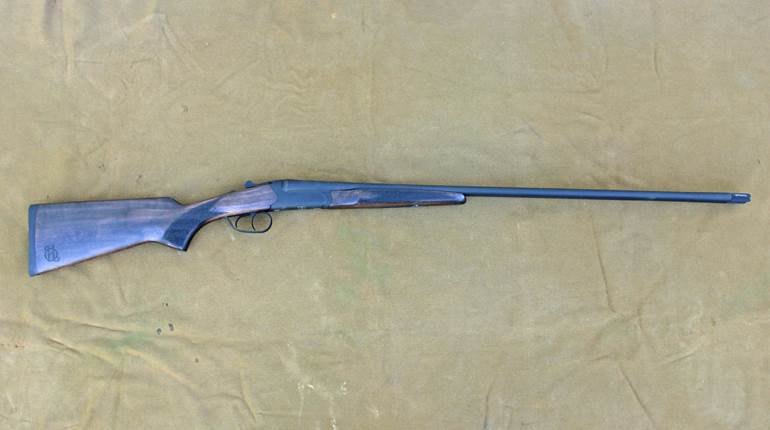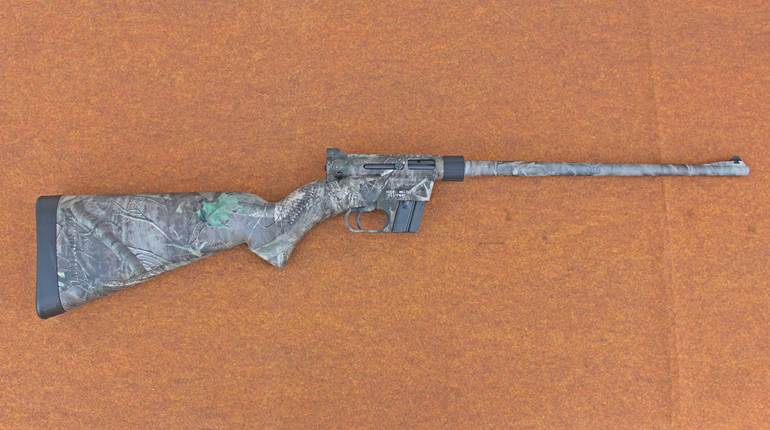
Like many folks who grew up in families fond of firearm-related activities, I learned to shoot with airguns. But once I was old enough to start shooting rimfire rifles, the airguns went the way of many childhood things. They were packed up, put away, and all but forgotten.
Recently, I’ve been taking a second look at air rifles. With rimfire ammunition so scarce the last couple of years, finding another way to enjoy rimfire-like target shooting seems to be a good idea. While pondering the available options, an associate sent an email describing the new Turkish-made Hatsan USA air rifles that were about to hit the American market. Unlike some of the relatively simple airguns I've handled in the past, the Model 125 Vortex Sniper is loaded with target shooting features and accessories but at a reasonable price. And so, I requested one for a test drive.
The 125 Vortex Sniper is a high performance break-action, single-shot air rifle. Powered by a gas piston system, the rifle is cocked by pressing the hinged barrel down toward the trigger guard and then swinging it back into the closed position. No pumping or external gas canisters are required. The use of a gas piston, in place of a heavy spring, makes this rifle much quieter to shoot and eliminates the vibration caused by a spring's oscillation. This model has Hatsan’s Shock Absorber System (S.A.S.) incorporated into its design to further reduce felt vibration. The rifle's piston can remain cocked for long periods of time, it works reliably in cold weather, and offers a longer service life than a spring.
This particular air rifle is available in standard pellet chamber sizes, including .177, .22, or .25-caliber. Hatsan rates the .177-caliber model at 1250 feet per second (fps), the .22 caliber model at 1000 fps, and the .25 caliber model at 750 fps. Depending on the caliber and weight of the pellet fired, the rifles produce around 28 to 36 foot-pounds of energy, at the muzzle, for target shooting, small game hunting, and pest control. Because of the relatively high levels of energy produced by the 125 Vortex Sniper, Hatsan recommends the use of all-lead pellets because light weight alloy pellets can chip or break resulting in poor accuracy.
With an overall length of 48.8 inches and an un-accessorized weight of 9.3 pounds, the 125 Sniper Vortex neither looks nor handles like a kid’s airgun. Instead, its features and accessories are intended for serious shooting. The 19.6-inch barrel, the cocking arm, receiver/piston assembly, and trigger are all constructed of blued steel. The rifle is topped with TruGlo fiber optic iron sights, with a fixed front sight and fully adjustable rear sight. The receiver is fitted with a scope rail. The polymer canister attached to the barrel, supporting the front sight, operates as both a sound moderator and a muzzle break. Located at the rear of the receiver is an ambidextrous polymer safety knob which is easily engaged and disengaged using the thumb of the shooting hand.
The black polymer stock provides an adult-friendly 14-inch length-of-pull (LOP), a height-adjustable Monte Carlo cheek piece, sling swivels, and a soft rubber butt pad. The LOP can be increased up to 14.75 inches by installing one or more of the three provided Triopad stock inserts. Soft rubber grip inserts are placed along the sides of the stock's fore-end and the pistol grip. A polymer trigger guard houses the steel bow trigger which is fully adjustable for both trigger pull and trigger travel. From the factory, the smooth trigger required just 2 pounds 12ounces of pressure to cycle.
The 125 Sniper Vortex would be ready for the range with the features listed so far, but Hatsan threw a few more goodies into the box to sweeten the deal. There was a polymer bipod to clip onto the barrel for bench-rest shooting and an adjustable sling. And to complete the rifle there was an Optima 3-9x32 scope provided with see-through scope rings to allow the shooter to use the fiber optic sights with the scope installed. The only thing left to add to the rifle package was some lead pellets.
For this review, the .22-caliber version of the gun was tested. Although the .177-caliber air rifles are among the most popular pellet poppers in the United States, finding pellets for the larger .22 version is not hard if you know where to look. Hatsan USA provides an in-house Vortex Supreme line of lead pellets, which can be ordered from the company but are not included with the rifle. But it made sense to expand the ammunition test set to include other readily available brands, styles, and weights. The folks over at Bass Pro Shop provide a top-notch selection of .22-caliber lead pellets designed for high-performance air rifles including Benjamin, Crosman, and Gamo pellets. Bass Pro was kind enough to provide samples from each brand for testing. I was also able to get a hold of some JSB Match Diablo pellets as well.
Hatsan USA, like other airgun manufacturers, recommends a 100 to 200 round break-in period for their rifles. During that break-in at the range, the rifle proved to be perfectly reliable with every pellet type I could feed it. Besides its length and weight, the 125 Sniper Vortex demonstrated itself to be an adult air rifle in the amount of pressure needed to fully cock the gun between shots. Although the cocking process seemed to be perfectly manageable for the average adult, the piston’s level of resistance was strong enough that small-framed or youth shooters could find it a challenge to operate.
After a morning of quiet, low-recoil plinking to break in the 125 Sniper Vortex, it was tucked into a bench-mounted rifle rest for formal accuracy testing. The optic was used to fire into targets set at 25 yards. It should come as no surprise that the Hatsan Vortex Supreme 14.66-grain lead dome pellets produced the best single group of 1.31-inches, and the best 5-group average of 1.48 inches, since the pellets were German-engineered especially for Hatsan rifles.
However, the three additional pellet varieties launched during formal accuracy testing were comparable in their performance. Crossman Premier 14.30-grain lead dome hollow-points produced a best single group of 1.34 inches with an average of 1.5 -inches. Gamo TS-22 Long Distance 22-grain lead dome pellets turned in a best group of 1.49-inches and averaged 1.59 inches, followed by JSB Match Diablo’s Predator Int. Metalmag 17-grain metallic-tipped lead pellets with a best of 1.54 inches and an average of 1.66 inches.
Overall, I would say this foray into high-performance pellet rifles was a positive adventure. Hatsan has been producing airguns under other brand names for years and the quality of their craftsmanship shows in this rifle. This particular model arrived from the factory with a truly range-ready set of accessories included in the box. As of this writing, packages of high-quality lead .22 pellets are available for around $15, making airguns like this one an affordable alternative to rimfire shooting while ammo is scarce. But based on this shooting test, I can see why so many folks choose airgunning as a hobby. With a real world price hovering around $300, the Hatsan USA 125 Vortex Sniper package is well worth the investment.
Technical Specifications
Manufacturer: Hatsan USA
Model: 125 Sniper Vortex
Action: Break-Action Gas Piston Airgun
Caliber: .22 Cal (5.5mm)
Finish: Blued Steel
Stock: Black Polymer, Adjustable Monte Carlo Cheek Piece, Rubber Butt Pad
Sights: TruGlo Fiber Optic Front, Adjustable TruGlo Fiber Optic Rear
Optic: Optima 3-9x32
Barrel Length: 19.6 Inches
Overall Length: 48.8 Inches
Weight: 9.3 Pounds
Capacity: 1 Round
Twist: 1:15.75” RH
Rifle Grooves: 12
Accessories: 3 Stock Spacers, Scope, Adjustable Sling, Bipod
Suggested Retail: $363.59























![Winchester Comm[94]](/media/1mleusmd/winchester-comm-94.jpg?anchor=center&mode=crop&width=770&height=430&rnd=134090756537800000&quality=60)
![Winchester Comm[94]](/media/1mleusmd/winchester-comm-94.jpg?anchor=center&mode=crop&width=150&height=150&rnd=134090756537800000&quality=60)












